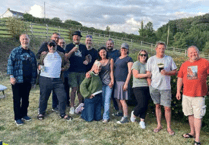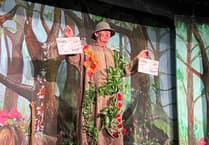There's a lot to see on a short walk close to home for Nature photographer Ray Roberts ....Sometimes when the mind is willing but the body is weak, I just take a short walk around the village as I did last Sunday.
My first stop was beside the stone wall around the school where some lichen was growing on the stones. These were green with a short stem and a cup shaped top, commonly known as cup lichens. It appears that there are over thirteen hundred different lichens in Britain that grow on tree trunks, slate roofs, fencing and stone.
There are some white ox-eye daisies still out in bloom and I even found a primrose down near the churchyard. Close to the Quethiock Oak there was a host of honey fungus growing in three groups on a thick tree stump and it was interwoven with ivy runners.
This fungus is one of the most dangerous parasites of living trees as it causes fungal rot which eventually kills its host, in fact the fungus is responsible for huge losses of trees every year. I remember having a walk through Highwood, near Liskeard, with a mushroom expert some years ago, when we came across half a dozen trees that were dying after being infected by honey fungus.
Growing nearby at the side of the road there were a few three-cornered leeks – Allium triquetrum – out in bloom. Now, this is a plant that flowers April – June so are these blooms early or late? They look similar to white bluebells but beware, if you think they would look nice in the front garden, forget it as they are extremely invasive and will quickly take over a large area of ground, as they have in St Hugh’s Churchyard. They are so named as their stems are triangular in shape.
Walking up to meet the road near East Quethiock Farm I noticed a lot of black tutsan berries waiting to be eaten by the local bird population and on a dried bramble stalk nearby I spotted some tiny white mushrooms. These, as far as I can tell, are Marasmius ramealis and are around 6mm to 8mm wide.
Just before I got home, I took a careful look on the stone wall opposite our entrance and saw several small sweet strawberries ready to pick. The odd thing is that when a picture of strawberry flowers on this wall was published back in April, a lady from Devon wrote to me saying I was wrong. They were barren strawberries, she said. I wrote back to her saying that I eat sweet fruits every year at this wall and barren strawberries bear no fruit at all!




